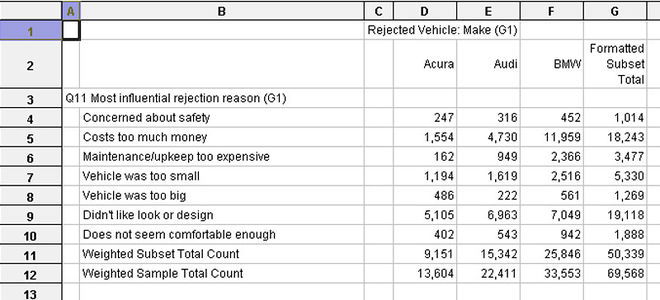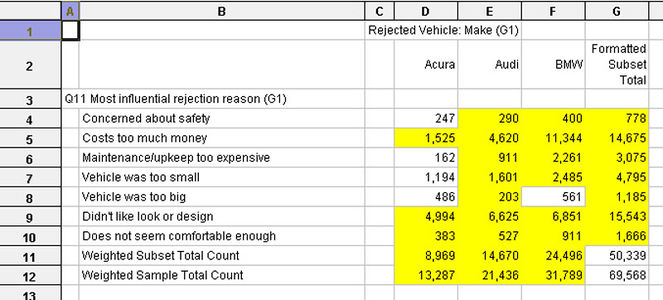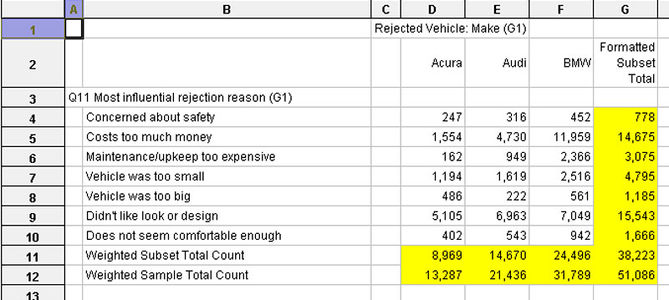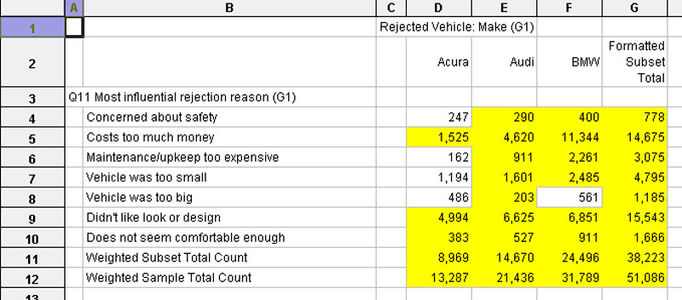Difference between revisions of "Use of the GROUP uniquing options"
| Line 2: | Line 2: | ||
| − | The group structure in mTAB neatly captures the data so that when the Make Rejected question is on the | + | The group structure in mTAB neatly captures the data so that when the Make Rejected question is on the columns and the Rejection Reasons on the rows, the data is automatically organized so that for each respondent, their answers to the reason question only show up under the relevant vehicles that they rejected. |
| − | + | [[File:Other use-of-the-GROUP-uniquing-options original.jpg|thumb|center|x300px]] | |
| − | + | mTAB offers many options to help you to control how your data is displayed. For Group questions, mTAB offers 2 more of these choices: '''Unique Group Data''' and '''Unique Group Totals''', which can be found under the '''View''' menu next to Study Weights. | |
| + | [[File:Other use-of-the-GROUP-uniquing-options view-options.jpg|thumb|center|x150px]] | ||
| − | + | When working with Group questions, we have to think that we are dealing with a number of respondents and that each of those respondents can provide more than one response to each question. Thus, we have a larger number of responses than respondents. These options basically look at a grid of numbers and look at the number of responses falling in to each cell. Then based on the options selected, it will either show all responses falling into that cell, or it will check if a certain respondent falls into a cell more than once and then it will unique their answers to only count once in that cell. | |
| − | + | These options are illustrated below with some examples and the cells that differ to the grid above are highlighted: | |
| − | + | ||
| − | + | Taking the grid of data shown, if we go to the '''View''' menu, select the '''Unique Group Data''' option, and run the tab, the results will change. | |
| − | + | [[File:Other use-of-the-GROUP-uniquing-options group-data.jpg|thumb|center|x300px]] | |
| + | This examined the underlying data and, anytime a single respondent falls in to a cell more than once, that respondent is uniqued to only count once in that cell. | ||
| − | |||
| + | If we again start with the grid of data originally shown above and we go to the '''View''' menu, select the '''Unique Group Totals''' option, and run the tab, the results will change again. | ||
| − | + | [[File:Other use-of-the-GROUP-uniquing-options group-totals.jpg|thumb|center|x300px]] | |
| + | |||
| + | This examined the underlying data in the Total rows and, anytime a single respondent falls in to a Total cell more than once, that respondent is uniqued to only count once in that total. | ||
| + | |||
| + | |||
| + | Finally, if we once again start with the grid of data originally shown above and go to the '''View''' menu, this time selecting both the Unique Group Data and Unique Group Totals options, and run the tab, the results will change again. | ||
| + | |||
| + | [[File:Other use-of-the-GROUP-uniquing-options both-data-totals.jpg|thumb|center|x300px]] | ||
| + | |||
| + | |||
| + | This examined the underlying data in the Total rows and the individual cells and, anytime a single respondent falls in to any cell more than once, that respondent is uniqued to only count once in that cell. | ||
| − | The data in these example sheets is displayed as weighted counts to help us to see the impact on each cell that an option has. | + | The data in these example sheets is displayed as weighted counts to help us to see the impact on each cell that an option has. If the data were formatted as percentages, each of these combinations of options would yield differing percentages in various areas of the sheet, as the underlying cell values and totals change. |
| − | These varying combinations allow | + | These varying combinations allow users to determine exactly how they would like the data to be represented and have the system represent the data that way, whether it is displayed as percentages, counts, means or medians. |
Revision as of 15:32, 30 July 2013
Within the mTAB software environment, it is possible to represent questions as what is referred to as Group questions. This question type is used when the underlying study question is represented on the questionnaire in the form of a grid, where a respondent is asked to evaluate more than one item and for each to answer a series of questions. An example would be to ask each respondent what vehicles they rejected when shopping for a new one and then, for each rejected vehicle ask what reasons caused them to reject this vehicle. This reason question will be a multi response question, as more than one reason may have caused the rejection of that vehicle.
The group structure in mTAB neatly captures the data so that when the Make Rejected question is on the columns and the Rejection Reasons on the rows, the data is automatically organized so that for each respondent, their answers to the reason question only show up under the relevant vehicles that they rejected.
mTAB offers many options to help you to control how your data is displayed. For Group questions, mTAB offers 2 more of these choices: Unique Group Data and Unique Group Totals, which can be found under the View menu next to Study Weights.
When working with Group questions, we have to think that we are dealing with a number of respondents and that each of those respondents can provide more than one response to each question. Thus, we have a larger number of responses than respondents. These options basically look at a grid of numbers and look at the number of responses falling in to each cell. Then based on the options selected, it will either show all responses falling into that cell, or it will check if a certain respondent falls into a cell more than once and then it will unique their answers to only count once in that cell.
These options are illustrated below with some examples and the cells that differ to the grid above are highlighted:
Taking the grid of data shown, if we go to the View menu, select the Unique Group Data option, and run the tab, the results will change.
This examined the underlying data and, anytime a single respondent falls in to a cell more than once, that respondent is uniqued to only count once in that cell.
If we again start with the grid of data originally shown above and we go to the View menu, select the Unique Group Totals option, and run the tab, the results will change again.
This examined the underlying data in the Total rows and, anytime a single respondent falls in to a Total cell more than once, that respondent is uniqued to only count once in that total.
Finally, if we once again start with the grid of data originally shown above and go to the View menu, this time selecting both the Unique Group Data and Unique Group Totals options, and run the tab, the results will change again.
This examined the underlying data in the Total rows and the individual cells and, anytime a single respondent falls in to any cell more than once, that respondent is uniqued to only count once in that cell.
The data in these example sheets is displayed as weighted counts to help us to see the impact on each cell that an option has. If the data were formatted as percentages, each of these combinations of options would yield differing percentages in various areas of the sheet, as the underlying cell values and totals change.
These varying combinations allow users to determine exactly how they would like the data to be represented and have the system represent the data that way, whether it is displayed as percentages, counts, means or medians.




